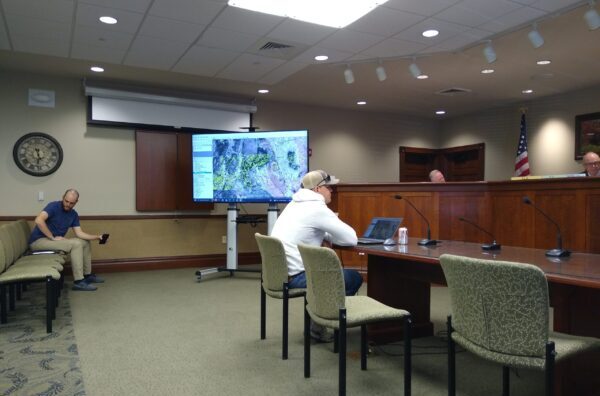This is an old news article. The events in this article are from March 2023.
(March 13, 2023) — The Garfield County commission met for a regularly scheduled meeting in Panguitch on March 13.
A New Resolution for Road Maintenance
The topic that garnered the most discussion during the meeting was a new resolution regarding the county’s road maintenance policies. Due to the county’s limited resources in road maintenance, the resolution does two things. First, it clarifies that the county is not required to accept the maintenance responsibility of newly developed roads. Second, it directs the Public Works Department to implement road maintenance priorities to help make sure resources are going to areas with the most need, based on overall benefit to the county’s residents.
The resolution comes during the spring melt, which has turned some gravel and dirt roads into impressive mires over the last couple weeks. But the resolution also addresses a longer-term problem — that of new residents’ high expectations of road maintenance to their private property.
The Issue of Out-of-State Property Owners
Inquiries about road maintenance and utilities, particularly from landowners living outside of Utah, have flooded county offices since the height of the pandemic. County Planner Kaden Figgins said he received numerous calls from people inquiring about the proposed changes in response to the county’s rezoning notice to landowners of several dry subdivisions this winter.
“Property owners affected by the proposed change would call saying they were going to retire at these properties or they were planning to do some type of commercial development,” Figgins said. He would then ask the landowner when they last visited the property, to which they would often say they had never been to Garfield County, let alone the property itself. Others would say they inherited the property from their late grandparents who purchased the property in the 1960s.
“It is not a developed subdivision with the road access and infrastructure you might expect,” Figgins would tell them. “There is not a public drinking water or wastewater disposal system, water rights are very difficult to obtain and transfer, you will need a minimum of one acre to drill a well and install a septic system, you need to run power to the property, [and] possibly develop a road.” And in several cases, he had to tell property owners that their “property is entirely undevelopable because the Sevier River now runs directly through your lot.”
Concerns about the Roads from Those Living Here
Others who have since moved here, or are actively visiting their property, have found access more difficult than they hoped for. Such is the case for several residents on Casto Canyon Road, which turns off Highway 89 a few miles south of Panguitch. Laura Bowers and Chad Stewart, both of Casto Canyon, addressed the commissioners about access problems during this year’s unprecedented melt.
Ms. Bowers asked about allocating more resources to maintaining Casto Canyon Road, citing safety and EMS access as her major concerns. She asked if, say, some property tax funds allocated to funding public schools, could be reallocated for road maintenance. County Clerk Camille Moore said that wouldn’t be possible since those allocations are dictated at the state level. Commissioner Pollock assured Ms. Bowers that if there was a medical emergency, she could call the sheriff’s office and they would get the patient out of there regardless of the road conditions.
Mr. Stewart asked if the county could at least send a grader in there to help drain the water off the road. But that wouldn’t be possible until after the road dries out, otherwise the heavy equipment would sink deeper into the road. The county plans to do some mitigation on that road as soon as conditions improve.
David Dodds, who manages the county’s road crew, estimated it would cost the county as much as $65,000 to improve just the one-mile stretch of Casto Canyon Road that residents need the most. Meanwhile the county has some 2,000 miles of other Class B roads to maintain, across 5,000 square miles — all on a limited budget.
Other Items
In other items, Commissioner Tebbs reported he had received some complaints from tenants in Neighborworks’ affordable housing development in Tropic. Those residents were concerned about what they said was too short a notice period on their option to purchase their homes in a rent-to-buy contract. The commissioners, scant on details, suspected that the problem might be a contractual one and would have to find out more later before stepping into the dispute.
Commissioner Pollock reported on the final week of Utah’s legislative season. He also provided a status update on the county’s effort to fight for multiple use on Grand Staircase-Escalante National Monument, which the BLM is currently drafting a new Resource Management Plan for. He affirmed what Commissioner Jerry Taylor had stated a month earlier, that the BLM is looking to hire a special interest group to write part of that plan. The Byway reported on this earlier this month.
Commissioner Pollock’s concern is that the RMP being developed, under considerable influence from environmentalists, will seek to turn much of the monument into a wilderness area with few roads, no access, and no groups over 12 heads. The county is working with the Utah Attorney General’s office and hiring a new range consultant, “to find the real science” to combat what he feels is manipulated science provided by environmental activists.
The commission approved the sale of four 2021 trucks to the four highest bidders. The county is able to purchase new trucks each year at a discount because it is a governmental entity. In most cases the county is then able to use them for a year and sell them for higher values. That was also the case this year: the four trucks were sold for an overall gain.
– The Byway
Read about the March 27 commission meeting here.

